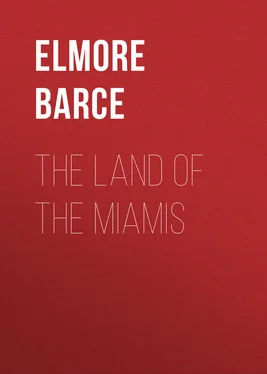Elmore Barce - The Land of the Miamis
Здесь есть возможность читать онлайн «Elmore Barce - The Land of the Miamis» — ознакомительный отрывок электронной книги совершенно бесплатно, а после прочтения отрывка купить полную версию. В некоторых случаях можно слушать аудио, скачать через торрент в формате fb2 и присутствует краткое содержание. ISBN: , Жанр: foreign_antique, foreign_prose, Историческая проза, на английском языке. Описание произведения, (предисловие) а так же отзывы посетителей доступны на портале библиотеки ЛибКат.
- Название:The Land of the Miamis
- Автор:
- Жанр:
- Год:неизвестен
- ISBN:http://www.gutenberg.org/ebooks/30244
- Рейтинг книги:4 / 5. Голосов: 1
-
Избранное:Добавить в избранное
- Отзывы:
-
Ваша оценка:
- 80
- 1
- 2
- 3
- 4
- 5
The Land of the Miamis: краткое содержание, описание и аннотация
Предлагаем к чтению аннотацию, описание, краткое содержание или предисловие (зависит от того, что написал сам автор книги «The Land of the Miamis»). Если вы не нашли необходимую информацию о книге — напишите в комментариях, мы постараемся отыскать её.
The Land of the Miamis — читать онлайн ознакомительный отрывок
Ниже представлен текст книги, разбитый по страницам. Система сохранения места последней прочитанной страницы, позволяет с удобством читать онлайн бесплатно книгу «The Land of the Miamis», без необходимости каждый раз заново искать на чём Вы остановились. Поставьте закладку, и сможете в любой момент перейти на страницу, на которой закончили чтение.
Интервал:
Закладка:
While the limits of the various tribes may not be fixed with precision, and the boundary lines were often confused, still there were well recognized portions of the northwest that were under the exclusive control of certain nations, and these nations were extremely jealous of their rights, as shown by the anger and resentment of the Miamis at what they termed as the encroachment of the Potawatomi at the Treaty of Fort Wayne, in 1809.
The Wyandots, for instance, were the incontestable owners of the country between the Cuyahoga and the Au Glaize, in the present state of Ohio, their dominion extending as far south as the divide between the waters of the Sandusky river and the Scioto, and embracing the southern shore of Lake Erie from Maumee Bay, to the mouth of the Cuyahoga. Large numbers of them were also along the northern shores of Lake Erie, in Canada. Their territory at one time probably extended much farther south toward the Ohio, touching the lands of the Miamis on the west, but certainly embracing parts of the Muskingum country, to which they had invited the ancient Delawares, respectfully addressed by them as "grandfathers." Intermingled with the Wyandots south and west of Lake Erie were scattered bands of Ottawas, but they were tenants of the soil by sufferance, and not as of right.
The Miamis have been described by General William Henry Harrison as the most extensive landowners in the northwest. He stands on record as saying that: "Their territory embraced all of Ohio, west of the Scioto; all of Indiana, and that part of Illinois, south of the Fox river and Wisconsin, on which frontier they were intermingled with the Kickapoos and some other small tribes." Harrison may have been right as to the ancient and original bounds of this tribe, but Little Turtle, their most famous chieftain, said at the Treaty of Greenville, in 1795: "It is well known by all my brothers present, that my fore-father kindled the first fire at Detroit; from thence, he extended his lines to the head-water of Scioto; from thence, to its mouth; from thence, down the Ohio, to the mouth of the Wabash, and from thence to Chicago, on Lake Michigan." The truth is, that the ancient demesne of the Miamis was much curtailed by the irruption of three tribes from the north in about the year 1765, the Sacs and Foxes, the Kickapoos and the Potawatomi, who conquered the old remnants of the Illinois tribes in the buffalo prairies and divided the country among themselves.
Says Hiram Beckwith, in speaking of the Potawatomi: "Always on friendly terms with the Kickapoos, with whom they lived in mixed villages, they joined the latter and the Sacs and Foxes in the exterminating war upon the Illinois tribes, and afterwards obtained their allotment of the despoiled domain." The Potawatomi advancing by sheer force of numbers, rather than by conquest, finally appropriated a large part of the lands in the present state of Indiana, north of the Wabash, commingling with the Kickapoos at the south and west, and advancing their camps as far down as Pine creek. The Miamis were loud in their remonstrances against this trespassing, and denounced the Potawatomi as squatters, "never having had any lands of their own, and being mere intruders upon the prior estate of others," but the Potawatomi were not dispossessed and were afterwards parties to all treaties with the United States government for the sale and disposal of said lands. The Miamis also lost a part of their lands on the lower west side of the Wabash to the Kickapoos. Pressing eastward from the neighborhood of Peoria, the Kickapoos established themselves on the Vermilion, where they had a village on both sides of that river at its confluence with the main stream. They were, says Beckwith, "Greatly attached to the Vermilion and its tributaries, and Governor Harrison found it a difficult task to reconcile them to ceding it away."
To the last, however, the Miamis remained the undisputed lords and masters of most of the territory watered by the two Miamis of the Ohio, and by the Wabash and its tributaries down to the Ohio. The great head and center of their power was at Kekionga (now Fort Wayne), always referred to by President Washington as "the Miami Village." It was a pleasant situation in the heart of the great northwest, at the junction where the swift flowing St. Joseph and the more gentle stream of the Saint Marys, formed the headwaters of the Maumee. On the eastern side of the St. Joseph was the town of Pecan, a head chief of the Miami, and the same savage who had supplied deer and buffalo meat for Brigadier General Harmar on his mission to Kaskaskia in 1787. Pecan was an uncle of the famous chief, Peshewah, or Jean Baptiste Richardville, who after the death of Little Turtle in 1812, became the head chief of the Miami tribe, and was reputed to be the richest Indian in North America. The southern end of this town was near the point of juncture of the St. Marys and St. Joseph, and the village extended north along what is now known as Lakeside, in the present city of Fort Wayne, a pleasant drive revealing at times the rippling waters of the river to the west. To the south of this village lay the Indian gardens, and east of the gardens the extensive corn fields and meadows. On the northern side of the town more corn fields were found, and north and west of it extended the forests. The banks of the Maumee just below the junction, and south of this old village, are quite high and steep, and along the northern side now runs the beautiful avenue known as Edgewater. Traveling down Edgewater to the eastward one comes to a great boulder with a brass tablet on it. You are at Harmar's Ford, and at the exact point where the regulars crossed the river just after sunrise of October 22nd, 1790, to attack the Indians. Here it was that Major John Wyllys fell leading the charge. Along the southern bank of the Maumee the ground is elevated and crowning these elevations were the forests again. It was through these forests that Hardin's forces approached the fatal battlefield.
On the western bank of the St. Joseph was a mixed village of French and Indians known as LeGris' Town, and it in turn was surrounded by more corn fields. LeGris was also an important chief of the Miamis, and named in Henry Hay's journal as a brother-in-law of the Little Turtle. He signed the treaty of Greenville under the Indian name of Na-goh-quan-gogh. Directly south of this village ran the St. Marys, and to the west of it was a small wooded creek known as Spy Run.
To these villages in August, 1765, came George Croghan on his way to Detroit. He describes the carrying-place between the Wabash and the Maumee systems to be about nine miles in length, "but not above half that length in freshes." He reported navigation for bateaux and canoes between the carrying place and Ouiatenon as very difficult during the dry season of the year on account of many rapids and rifts; but during the high-water time the journey could be easily made in three days. He says the distance by water was two hundred forty miles and by land about two hundred ten. Within a mile of Miamitown he was met by a delegation of the Miami chiefs and immediately after his entrance into the village the British flag was raised. He describes the villages as consisting of about forty or fifty cabins, besides nine or ten French houses. He entertained no very high opinion of the French and describes them as refugees from Detroit, spiriting up the Indians against the English. He describes the surrounding country as pleasant, well watered, and having a rich soil.
Recently another account of these villages has been given to the world by the publication of the diary of one Henry Hay, who, as a representative of certain merchants and traders of Detroit, visited these villages in the winter of 1789-1790, while they were still under the influence of the British agents at Detroit, although the soil was within the jurisdiction of the United States government. It was then one of the most important trading places for the Indian tribes in the northwest, and in close proximity to the great council grounds of the northwestern Indian confederacy in the valley of the Maumee. Le Gris, was there, and Jean Baptiste Richardville, then a youth; also the Little Turtle himself, about to become the most famous and wily strategist of his day and time.
Читать дальшеИнтервал:
Закладка:
Похожие книги на «The Land of the Miamis»
Представляем Вашему вниманию похожие книги на «The Land of the Miamis» списком для выбора. Мы отобрали схожую по названию и смыслу литературу в надежде предоставить читателям больше вариантов отыскать новые, интересные, ещё непрочитанные произведения.
Обсуждение, отзывы о книге «The Land of the Miamis» и просто собственные мнения читателей. Оставьте ваши комментарии, напишите, что Вы думаете о произведении, его смысле или главных героях. Укажите что конкретно понравилось, а что нет, и почему Вы так считаете.












